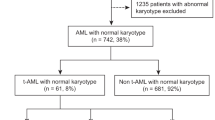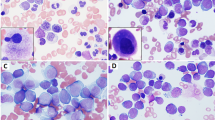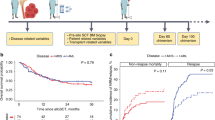Abstract
The aim of this study was to compare the pattern of karyotype abnormalities of therapy-related acute myeloid leukemia (t-AML) (n=93) with de novo AML (n=1091), and to evaluate their impact on prognosis. Favorable, intermediate, and unfavorable cytogenetics were observed in 25.8, 28.0, and 46.2% of t-AML, and in 22.2, 57.3, and 20.4% of de novo AML. The median overall survival (OS) was shorter in t-AML than in de novo AML (10 vs 15 months, P=0.0007). Favorable and unfavorable cytogenetics had a prognostic impact with respect to OS in both t-AML (P=0.001 and 0.0001) and de novo AML (P<0.0001 and <0.0001). To define the overall prognostic impact of cytogenetics and t-AML, a multivariate Cox's regression analysis was performed for OS with favorable cytogenetics, unfavorable cytogenetics, t-AML, age, and white blood cell (WBC) count as covariates. All parameters proved to be independently related to OS (P=0.001 for t-AML, P<0.0001 for all other parameters). Within patients with t-AML, there were significant correlations between OS and both unfavorable (P<0.0001) and favorable cytogenetics (P=0.001), while age and WBC count had no impact on OS. In conclusion, these data indicate that cytogenetics are an important prognostic parameter in t-AML. Furthermore, t-AML is an unfavorable factor independent of cytogenetics with respect to survival.
This is a preview of subscription content, access via your institution
Access options
Subscribe to this journal
Receive 12 print issues and online access
$259.00 per year
only $21.58 per issue
Buy this article
- Purchase on Springer Link
- Instant access to full article PDF
Prices may be subject to local taxes which are calculated during checkout



Similar content being viewed by others
References
Brunning RD, Matutes E, Harris NL, Flandrin G, Vardiman J, Bennett JM et al. Acute myeloid leukemia. In: Jaffe ES, Harris NL, Stein H, Vardiman J (eds). World Health Organization of Tumors Pathology and Genetics, Tumors of Haematopoietic and Lymphoid Tissues. Lyon: IARC Press, 2001, 75–108.
Kantarjian HM, Keating MJ, Walters RS, Smith TL, Cork A, McCredie KB et al. Therapy-related leukemia and myelodysplastic syndrome: clinical, cytogenetic, and prognostic features. J Clin Oncol 1986; 4: 1748–1757.
Pedersen-Bjergaard J, Philip P, Larsen SO, Jensen G, Byrsting K . Chromosome aberrations and prognostic factors in therapy-related myelodysplasia and acute nonlymphocytic leukemia. Blood 1990; 76: 1083–1091.
Johansson B, Mertens F, Heim S, Kristoffersson U, Mitelman F . Cytogenetics of secondary myelodysplasia (sMDS) and acute nonlymphocytic leukemia (sANLL). Eur J Haematol 1991; 47: 17–27.
Mauritzson N, Albin M, Rylander L, Billstrom R, Ahlgren T, Mikoczy Z et al. Pooled analysis of clinical and cytogenetic features in treatment-related and de novo adult acute myeloid leukemia and myelodysplastic syndromes based on a consecutive series of 761 patients analyzed 1976–1993 and on 5098 unselected cases reported in the literature 1974–2001. Leukemia 2002; 16: 2366–2378.
Smith SM, Le Beau MM, Huo D, Karrison T, Sobecks RM, Anastasi J et al. Clinical–cytogenetic associations in 306 patients with therapy-related myelodysplasia and myeloid leukemia: the University of Chicago Series. Blood 2003; 102: 43–52.
Pedersen-Bjergaard J, Andersen MK, Johansson B . Balanced chromosome aberrations in leukemias following chemotherapy with DNA-topoisomerase II inhibitors. J Clin Oncol 1998; 16: 1897–1898.
Cortes J, O'Brien S, Kantarjian HM, Cork A, Stass S, Freireich EJ . Abnormalities of the long arm of chromosome 11 (11q) in patients with de novo and secondary acute myelogenous leukemias and myelodysplastic syndromes. Leukemia 1994; 8: 2174–2178.
Quesnel B, Kantarjian HM, Pedersen-Bjergaard J, Brault P, Estey E, Lai JL et al. Therapy-related acute myeloid leukemia with t(8;21), inv(16), and t(8;16): a report on 25 cases and review of the literature. J Clin Oncol 1993; 11: 2370–2379.
Leone G, Mele L, Pulsoni A, Equitani F, Pagano L . The incidence of secondary leukemias. Haematologica 1999; 84: 937–945.
Pedersen-Bjergaard J, Philip P . Two different classes of therapy-related and de novo acute myeloid leukemia? Cancer Genet Cytogenet 1991; 55: 119–124.
Ellis M, Ravid M, Lishner M . A comparative analysis of alkylating agent and epipodophyllotoxin-related leukemias. Leukemia Lymphoma 1993; 11: 9–13.
Pedersen-Bjergaard J, Rowley JD . The balanced and the unbalanced chromosome aberrations of acute myeloid leukemia may develop in different ways and may contribute differently to malignant transformation. Blood 1994; 83: 2780–2786.
Felix CA . Secondary leukemias induced by topoisomerase-targeted drugs. Biochim Biophys Acta 1998; 1440: 233–255.
Pedersen-Bjergaard J, Philip P, Larsen SO, Andersson M, Daugaard G, Ersboll J et al. Therapy-related myelodysplasia and acute myeloid leukemia. Cytogenetic characteristics of 115 consecutive cases and risk in seven cohorts of patients treated intensively for malignant diseases in the Copenhagen series. Leukemia 1993; 7: 1975–1986.
Pedersen-Bjergaard J, Pedersen M, Roulston D, Philip P . Different genetic pathways in leukemogenesis for patients presenting with therapy-related myelodysplasia and therapy-related acute myeloid leukemia. Blood 1995; 86: 3542–3552.
Secker-Walker LM, Moorman AV, Bain BJ, Mehta AB, on behalf of the EU Concerted Action 11q23 Workshop. Secondary acute leukemia and myelodysplastic syndrome with 11q23 abnormalities. Leukemia 1998; 12: 840–844.
Pui C-H, Relling MV, Rivera GK, Hancock ML, Raimondi SC, Heslop HE et al. Epipodophyllotoxin-related acute myeloid leukemia: a study of 35 cases. Leukemia 1995; 9: 1990–1996.
Stanulla M, Wang J, Chervinsky DS, Aplan PD . Topoisomerase II inhibiotrs induce DNA double-strand breaks at a specific site within the AML1 locus. Leukemia 1997; 11: 490–496.
Andersen MK, Johansson B, Larsen SO, Pedersen-Bjergaard J . Chromosomal abnormalities in secondary MDS and AML. Relationship to drugs and radiation with specific emphasis on the balanced rearrangements. Haematologica 1998; 83: 483–488.
Detourmignies L, Castaigne S, Stoppa AM, Harousseau J-L, Sadoun A, Janvier M et al. Therapy-related acute promyelocytic leukemia: a report on 16 cases. J Clin Oncol 1992; 10: 1430–1435.
Gardin C, Chaibi P, de Revel T, Rousselot P, Turlure P, Miclea JM et al. Intensive chemotherapy with idarubicin, cytosine arabinoside, and granulocyte colony-stimulating factor (G-CSF) in patients with secondary and therapy-related acute myelogenous leukemia. Club de Reflexion en Hematologie. Leukemia 1997; 11: 16–21.
Kern W, Haferlach T, Schoch C, Löffler H, Gassmann W, Heinecke A et al. Early blast clearance by remission induction therapy is a major dependent prognostic factor for both achievement of complete remission and long-term outcome in acute myeloid leukemia: data from the German AML Cooperative Group (AMLCG) 1992 Trial. Blood 2003; 101: 64–70.
Lengfelder E, Reichert A, Schoch C, Haase D, Haferlach T, For the German AML Cooperative Group et al. Double induction strategy including high dose cytarabine in combination with all-trans retinoic acid: effects in patients with newly diagnosed acute promyelocytic leukemia. Leukemia 2000; 14: 1362–1370.
Haferlach T, Schoch C, Löffler H, Gassmann W, Kern W, Schnittger S et al. Morphologic dysplasia in de novo acute myeloid leukemia (AML) is related to unfavorable cytogenetics but has no independent prognostic relevance under the conditions of intensive induction therapy: results of a multiparameter analysis from the German AML Cooperative Group Studies. J Clin Oncol 2003; 21: 256–265.
Schoch C, Schnittger S, Bursch S, Gerstner D, Hochhaus A, Berger U et al. Comparison of chromosome banding analysis, interphase- and hypermetaphase-FISH, qualitative and quantitative PCR for diagnosis and for follow-up in chronic myeloid leukemia: a study on 350 cases. Leukemia 2002; 16: 53–59.
Mitelman F (ed). ISCN 1995, Guidelines for Cancer Cytogenetics, Supplement to: An International System for Human Cytogenetic Nomenclature. S Karger, 1995.
Kaplan E, Meier P . Nonparametric estimation from incomplete observations. J Am Statist Assoc 1958; 53: 456–481.
Peto R, Pike MC, Armitage P, Breslow NE, Cox NR, Howard SV et al. Design and analysis of randomized clinical trials requiring prolinged observation of each patient. Br J Cancer 1977; 35: 1–39.
Karp JE, Smith MA . The molecular pathogenesis of treatment-induced (secondary) leukemias: Foundation for treatment and prevention. Semin Oncol 1997; 24: 103–113.
Byrd JC, Mrózek K, Dodge RK, Carroll AJ, Edwards CG, Arthur DC et al. Pretreatment cytogenetic abnormalities are predictive of induction success, cumulative incidence of relapse, and overall survival in adult patients with de novo acute myeloid leukemia: results from Cancer and Leukemia Group B (CALGB 8461). Blood 2002; 100: 4325–4336.
Grimwade D, Walker H, Oliver F, Wheatley K, Harrison C, on behalf of the Medical Research Council Adult and Children's Leukemia Working Parties et al. The importance of diagnostic cytogenetics on outcome in AML: analysis of 1612 patients entered into the MRC AML 10 trial. Blood 1998; 92: 2322–2333.
Grimwade D, Walker H, Harrison G, Oliver F, Chatters S, on behalf of the Medical Research Council Adult Children's Leukemia Working Parties et al. The predictive value of hierarchical cytogenetic classification in older adults with acute myeloid leukemia (AML): analysis of 1065 patients entered into the United Kingdom Medical Research Council AML 11 trial. Blood 2001; 98: 1312–1320.
Slovak ML, Kopecky KJ, Cassileth PA, Harrington DH, Theil KS, for the SWOG and ECOG et al. Karyotypic analysis predicts outcome of preremission and postremission therapy in adult acute myeloid leukemia: a Southwest Oncology Group/Eastern Cooperative Oncology Group study. Blood 2000; 96: 4075–4083.
Moorman AV, Roman E, Willett EV, Dovey GJ, Cartwright RA, Morgan GJ . Karyotype and age in acute myeloid leukemia. Are they linked? Cancer Genet Cytogenet 2001; 126: 155–161.
Schoch C, Kern W, Krawitz P, Dugas M, Schnittger S, Haferlach T et al. Dependence of age-specific incidence of acute myeloid leukemia on karyotype. Blood 2001; 98: 3500.
Mauritzson N, Johansson B, Albin M, Billstrom R, Ahlgren T, Mikoczy Z et al. A single-center population-based consecutive series of 1500 cytogenetically investigated adult hematological malignancies: karyotypic features in relation to morphology, age and gender. Eur J Haematol 1999; 62: 95–102.
Rowley JD, Olney HJ . International workshop on the relationship of prior therapy to balanced chromosome aberrations in therapy-related myelodysplastic syndromes and acute leukemia: overview report. Genes Chromosomes Cancer 2002; 33: 331–345.
Ballen KK, Antin JH . Treatment of therapy-related acute myelogenous leukemia and myelodysplastic syndromes. Hematol Oncol Clin N Am 1993; 7: 477–493.
Michels SD, McKenna RW, Arthur DC, Brunning RD . Therapy-related acute myeloid leukemia and myelodysplastic syndrome: a clinical and morphologic study of 65 cases. Blood 1985; 65: 1364–1372.
Hoyle CF, de Bastos M, Wheatley K, Sherrington PD, Fischer PJ, Rees JK et al. AML associated with previous cytotoxic therapy, MDS or myeloproliferative disorders: results from the MRC's 9th AML trial. Br J Haematol 1989; 72: 45–53.
Büchner T, Hiddemann W, Wörmann B, Löffler H, Gassmann W, Haferlach T et al. Double induction strategy for acute myeloid leukemia: the effect of high-dose cytarabine with mitoxantrone instead of standard-dose cytarabine with daunorubicin and 6-thioguanine: a randomized trial by the German AML Cooperative Group. Blood 1999; 93: 4116–4124.
Cortes J, Kantarjian HM, O'Brien S, Keating MJ, Pierce S, Freireich EJ et al. Clinical and prognostic significance of trisomy 21 in adult patients with acute myelogenous leukemia and myelodysplastic syndromes. Leukemia 1995; 9: 115–117.
Slovak ML, Bedell V, Popplewell L, Arber DA, Schoch C, Slater R . 21q22 balanced chromosome aberrations in therapy-related hematopoietic disorders: report from an international workshop. Genes Chromosomes Cancer 2002; 33: 379–394.
Andersen MK, Larson RA, Mauritzson N, Schnittger S, Jhanwar SC, Pedersen-Bjergaard J . Balanced chromosome abnormalities inv(16) and t(15;17) in therapy-related myelodysplastic syndromes and acute leukemia: report from an international workshop. Genes Chromosomes Cancer 2002; 33: 395–400.
Degos L, Dombret H, Chomienne C, Daniel MT, Micléa J-M, Chastang C et al. All-trans-retinoic acid as a differentiating agent in the treatment of acute promyelocytic leukemia. Blood 1995; 85: 2643–2653.
Fenaux P, Castaigne S, Dombret H, Archimbaud E, Duarte M, Morel P et al. All-trans retinoic acid followed by intensive chemotherapy gives a high complete remission rate and may prolong remission in newly diagnosed acute promyelocytic leukemia: a pilot study on 26 cases. Blood 1992; 80: 2176–2181.
Fenaux P, Le Deley MC, Castaigne S, Archimbaud E, Chomienne C, and the European APL 91 Group et al. Effect of all-trans retinoic acid in newly diagnosed acute promyelocytic leukaemia. Results of a multicenter randomised study. Blood 1993; 82: 3241–3249.
Warrell RP, Maslak P, Eardley A, Heller G, Miller WH et al. Treatment of acute promyelocytic leukemia with all-trans retinoic acid: an update of the New York experience. Leukemia 1994; 8: 929–933.
Pulsoni A, Pagano L, Lo Coco F, Avvisati G, Mele L, Di Bona E et al. Clinicobiological features and outcome of acute promyelocytic leukemia occurring as a second tumor: the GIMEMA experience. Blood 2002; 100: 1972–1976.
Acknowledgements
The cell samples included in this study were sent for central diagnostics from various hospitals in Germany participating in the AMLCG trials (coordinators: T Büchner and W Berdel, Münster; W Hiddemann, München; B Wörmann, Braunschweig, Germany; statisticians: A Heinecke, MC Sauerland, Münster, Germany). We thank the coordinators and the statisticians of this study for their continuous support, as well as all clinicians for providing cell samples and clinical data.
Author information
Authors and Affiliations
Corresponding author
Rights and permissions
About this article
Cite this article
Schoch, C., Kern, W., Schnittger, S. et al. Karyotype is an independent prognostic parameter in therapy-related acute myeloid leukemia (t-AML): an analysis of 93 patients with t-AML in comparison to 1091 patients with de novo AML. Leukemia 18, 120–125 (2004). https://doi.org/10.1038/sj.leu.2403187
Received:
Accepted:
Published:
Issue Date:
DOI: https://doi.org/10.1038/sj.leu.2403187
Keywords
This article is cited by
-
Recent advances in targeted therapies in acute myeloid leukemia
Journal of Hematology & Oncology (2023)
-
Poor outcome of allogeneic transplantation for therapy-related acute myeloid leukemia induced by prior chemoradiotherapy
Annals of Hematology (2023)
-
Single-center phase 2 study of PD-1 inhibitor combined with DNA hypomethylation agent + CAG regimen in patients with relapsed/refractory acute myeloid leukemia
Cancer Immunology, Immunotherapy (2023)
-
The complex karyotype in hematological malignancies: a comprehensive overview by the Francophone Group of Hematological Cytogenetics (GFCH)
Leukemia (2022)
-
How Genetics Can Drive Initial Therapy Choices for Older Patients with Acute Myeloid Leukemia
Current Treatment Options in Oncology (2022)



